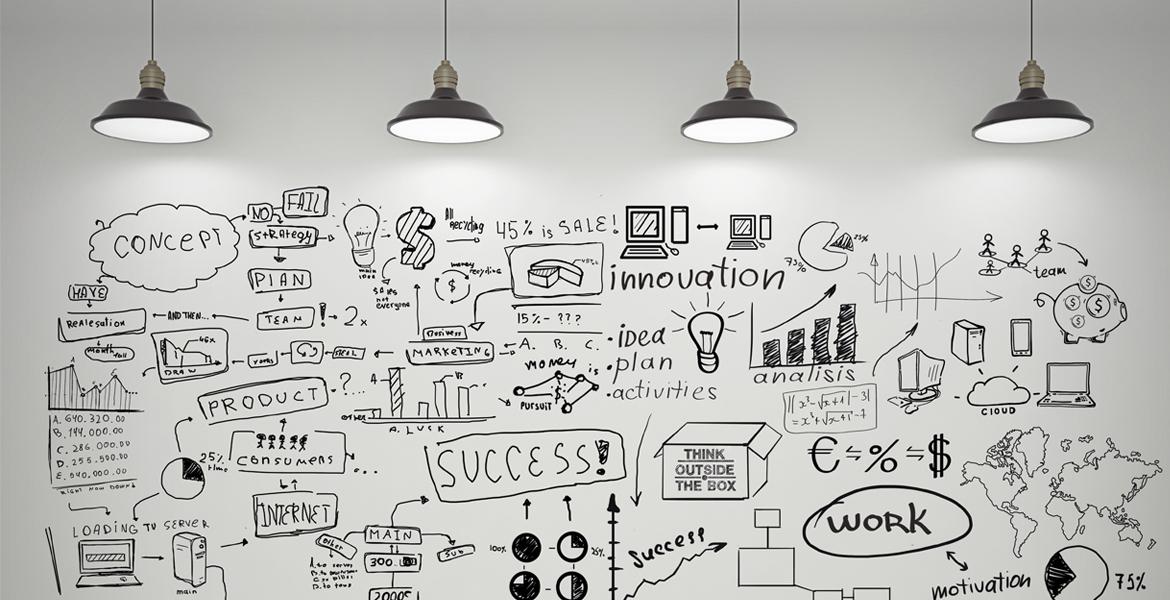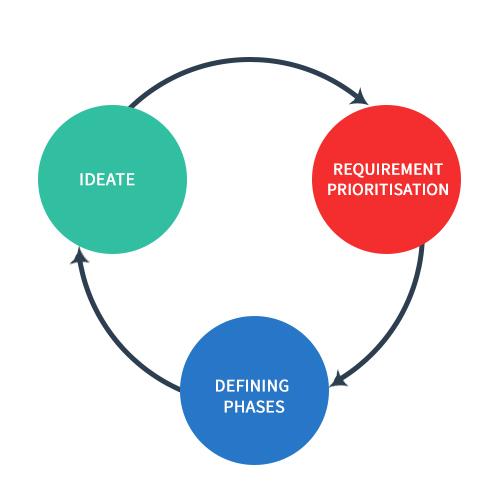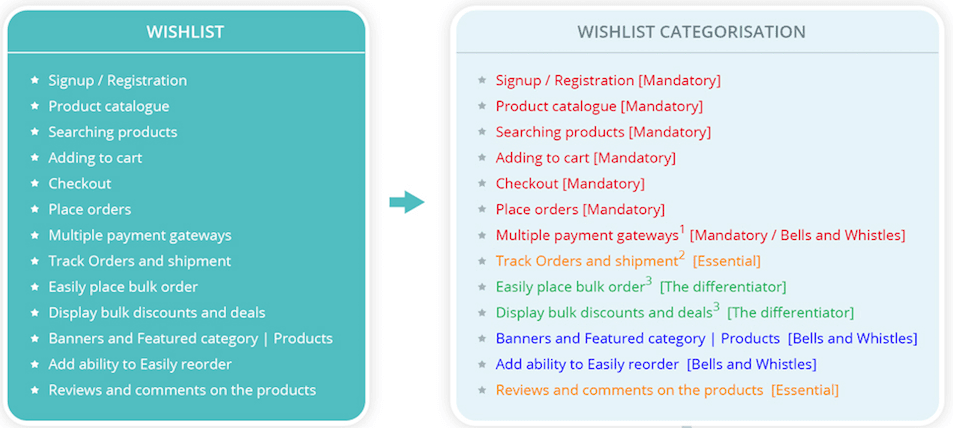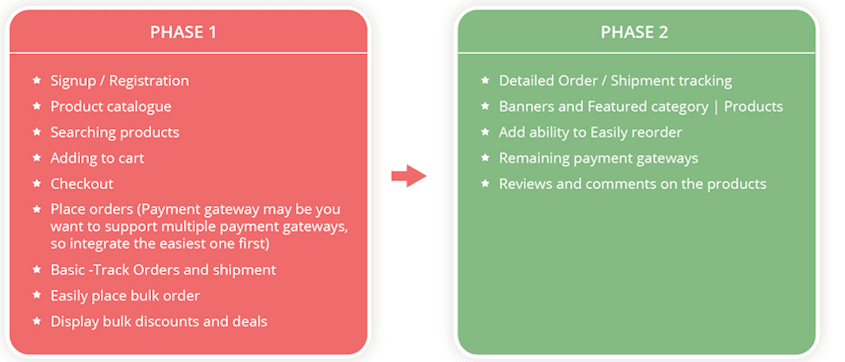Startup: How to plan your product development?
Posted by Pranjal on February 24, 2017

As an entrepreneur when we plan to get a product developed, we think about many features and come up with a long (wish)list that we think will make our application unique and make it stand out in already cluttered marketplace. And since we are constantly thinking about our product and it's features, all the features that we think about, seem really important to get that #kickAss product created.
Any intelligent fool can make things bigger and more complex... It takes a touch of genius and a lot of courage to move in the opposite direction."
- Albert Einstein
This is where is gets confusing for entrepreneurs on how to get the development done because if product will be shipped out after all the features are implement it may take months (and at times years) before product will see the light of the day.
At CodeFire we have been privileged to work with many startups and entrepreneurs (technical and nontechnical) in last 6 years of our existence. With that experience and having seen what works and what does not, we have come to a conclusion that development in phases really well for startups. Below is an approach that tries to bring method to the madness called #startup product development
Development in well planned phases is recommended approach for #startups.
As a startup if you want to stay relevant, you need to keep coming up with newer and powerful ideas. However, to effectively execute those ideas is equally, if not more, important. Hence, you need to prioritize the ideas and then break them in phases for development. So, ideating and prioritizing need to be clearly defined separate phases and intermixing is harbinger of disaster.
1. Ideation Step:
- Jot down the wishlist- Jot down everything that you can think of. This is a never ending process since as you think/discuss/review more you get more ideas. So try to note down everything as far as you can.
- What makes your product unique: Jot down what makes your product / service unique as that differentiates from the masses
2. Requirement Prioritization Step:
Before you get started with the actual product development, you need prioritize the wish list to get the development done in a planned manner. Development in well planned phases is recommended approach for startups. Based on the wish list, you need to decide which features need to be part of initial launch and make a minimum viable product (MVP). And then what comes in next phases of development. So it is at this stage that you need to differentiate between core product and bells and whistles.
Unless entrepreneurs have some technical / software background, they find it really difficult to break things down in logical phases and I have seen many projects fail just because of this reason. If you are not technical yourself, then this is where you need an expert development partner who has expertise in project development and can help you with logical grouping of your requirements (wish list).
Many Software development projects fail just because Entrepreneurs attempted to get everything done in one go and project became too big to be handled with external teams.
Buckets that you can use to categorize your wish list are:
Mandatory features: Without this nothing works
The Differentiator: What makes your product / service unique
Essential Features: These are important to have features, but the customer may not use on day one or for a couple weeks after launch.
Bells and whistles: Add on features that your customers will love to have since these will make things really easy for them within this application.
3. Defining Phases Step:
Once you have categorized the features under above mentioned buckets, it becomes very easy to see what is really important to get done and what can be done later and hence it can lead to clearly defining phases in which development can happen.
You need to include all Mandatory and The differentiator features in the immediate phase and keep Essential and Bells and Whistles for later phases.

Rome was not built in a day, anything worth building takes time!
Reasons why development in phases works:
Quick to market: If you are going to build the complete product and then go to market it will take comparatively more time. For startups it really matters a lot on how quickly they are able to launch and reach the customer. Being first (quick) to the market always has its advantages.
Validate the core idea quickly: If you can get the MVP out quickly and get it to target customers, then this can really validate your ideas quickly.
Course correction is less expensive: In case you observe that something you thought would work and is not working as effectively, you can change direction instead of investing huge amount of time and money on something that customers may not like.
Increased customer engagements: Since the development is happening in phases, your customers get to see new features regularly and who doesn't like see newer / better features in the products that they already love.
Understanding consumer behavior: When a general consumer goes to a new site, they spend sometime there if they like it they would register and probably bookmark to explore it later. And when the same site they liked earlier sends a message that new features have been added, that not only adds a recall value but also compels user to go back and review the site. And stats suggest that unless you are offering that no one else is, actual transactions take more than couple visits.
New Ideas: Since as in Entrepreneur, you are constantly ideating and thinking/discussing about new possibilities, when you are developing in phases, you can change priority for next phase development since development has not yet been started on that and it will not involve too much cost to manage that change.
Entrepreneur's apprehension about phased development:
Entrepreneur's do not feel very comfortable with idea of development in phases. Following are some of the reasons why they feel so. However, once they go through the process we have seen entrepreneurs swear by the positive results they see with this approach.
Essential features missing: Entrepreneurs spend a lot of time ideating on how each additional feature adds value to overall product and hence have a hard time visualizing how system will work without that feature. And hence they want everything done in one go so that they do not loose even a single customer because of that missing feature.
Cost of development: A lot of times Entrepreneurs feel more comfortable when they are able to get the complete cost of all features estimated and finalized since getting development done in phases seems more expensive to them.
Development companies push for single phase delivery: Since this buys them more time to deliver the project and obviously monitory value of full project is generally a lot more than different phases.
We at CodeFire have seen this work and this is how we formulated this approach. It is in line with this that we have devised our customized development methodology for startup products.
Case Study:
Lets assuming you are planning to develop an eCommerce store for bulk buyers. Below is the set of features that we think are important for this eCommerce store
- Signup / Registration
- Product catalogue
- Searching products
- Adding to cart
- Checkout - Place orders - Multiple payment gateways
- Track Orders and shipment
- Easily place bulk order
- Display bulk discounts and deals
- Banners and Featured category | Products
- Add ability to Easily reorder
- Reviews and comments on the products
So once we have all the wish list we go through the first step of Categorization as displayed below:

- Multiple payment gateways are not needed in first go but at least one is mandatory
- Detailed order and shipment tracking may not be needed on day one as long as you have basic tracking there. Since, it will take sometime for the site to become popular and for customers to convert and buy.
- 3. Since our target audience is bulk buyers and this will differentiate us from other eCommerce stores
Once the categorization has been done, it is really easy to divide the requirements into phases for development, as we have done below.

About CodeFire:
CodeFire is high-tech technology company with sharp focus on product development for startups. We have been following our customized development methodology for startup products and have seen it work well. If you have a concept and want to move to next step, ping us we will be happy to discuss and help you with whatever we can.

 Business:
Business:  Call us on:
Call us on: H 92, Ground Floor. Sector 63, Noida, U.P
H 92, Ground Floor. Sector 63, Noida, U.P